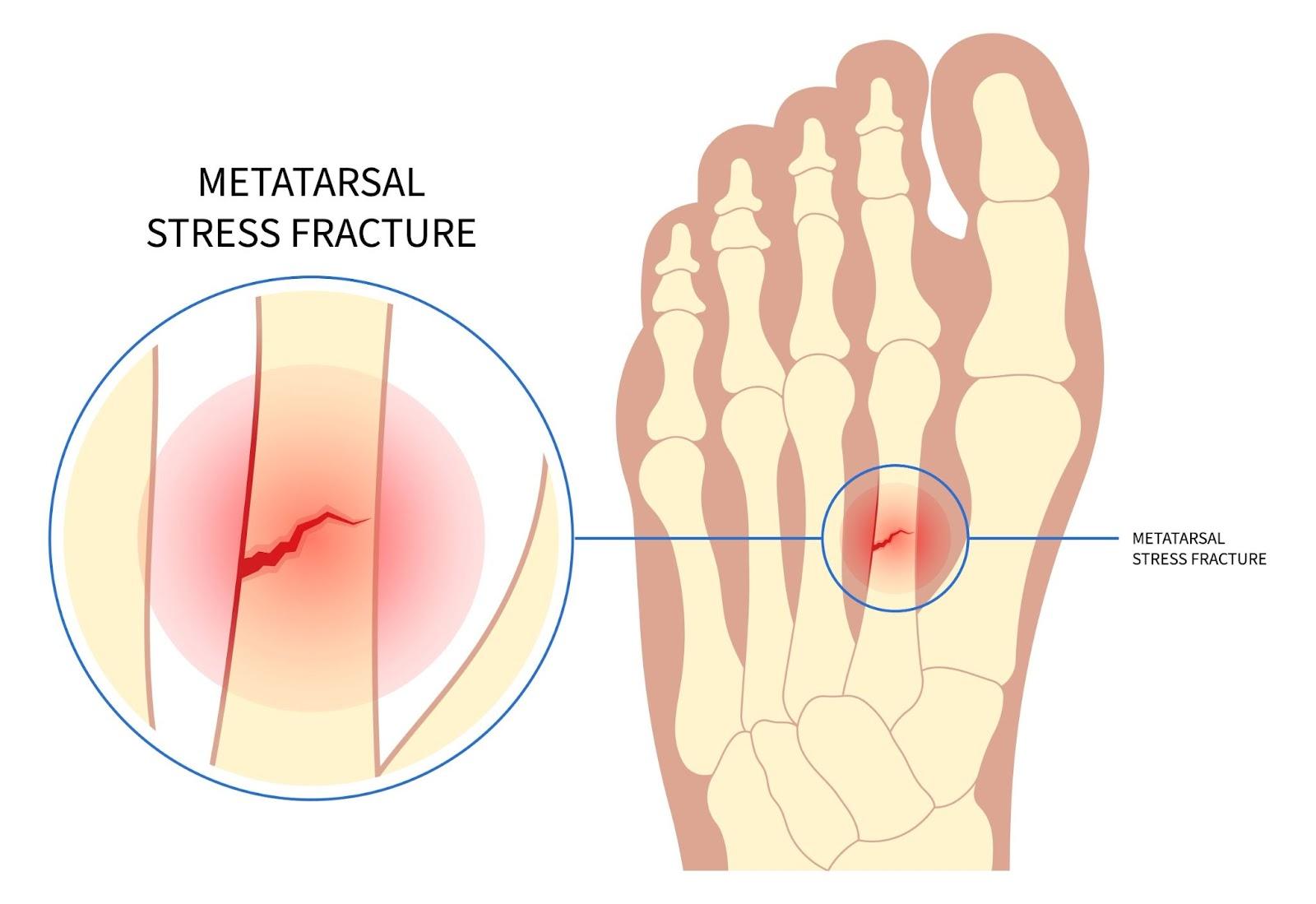Stress Fracture of the Foot

A stress fracture is a small crack or bruising in the weight-bearing bones of the foot, caused by repetitive stress or overuse.
What is a stress fracture of the foot?
A stress fracture of the foot is a small crack or severe bruising within a bone, commonly caused by repetitive stress or overuse. Unlike acute fractures, which occur due to a single traumatic event, stress fractures develop gradually over time as a result of repeated strain on the bones. These injuries are most prevalent in weight-bearing bones of the foot, including:
- Metatarsals — these long bones in the forefoot are particularly vulnerable to stress fractures, especially the second and third metatarsals, as they endure significant pressure during activities such as running and jumping.
- Navicular Bone — located on the top of the midfoot, the navicular bone plays a critical role in weight distribution. Stress fractures here are often seen in athletes and are sometimes challenging to diagnose.
- Calcaneus (Heel Bone) — as the largest bone in the foot, the calcaneus absorbs much of the impact during weight-bearing activities. Stress fractures here can cause pain in the heel, especially during walking or running.
Stress fractures occur when the muscles supporting the foot become fatigued and can no longer absorb the impact of repetitive activities effectively. The excess strain is transferred to the bone, leading to small cracks over time. While these fractures are common among athletes, they can also affect individuals who suddenly increase their activity levels or wear improper footwear.
There are two primary classifications of stress fractures:
- Fatigue fractures — resulting from abnormal stress on healthy bone due to overuse or improper mechanics.
- Insufficiency fractures — occurring when normal stress is applied to bones weakened by conditions such as osteoporosis or poor bone density.
Understanding the specific location and type of stress fracture is crucial for proper diagnosis and treatment. Left untreated, these fractures can worsen—potentially leading to complete breaks or long-term complications. Early intervention can prevent further damage and support a full recovery.
What causes a stress fracture in the foot?
Stress fractures in the foot are caused by repetitive mechanical stress that exceeds the bone’s ability to repair and adapt. When the foot is subjected to repeated loading during activities such as walking, running, or jumping, the bones naturally undergo microscopic damage. Under normal conditions, this micro-damage is repaired during periods of rest, which allows the bones to become stronger and more resilient. However, when the rate of stress surpasses the bone’s capacity to recover, the repair process is disrupted, leading to the development of small cracks within the bone structure.
Over time, if the repetitive impact is too great or prolonged, certain areas of the bone experience concentrated stress, causing localised damage. This process is exacerbated when the surrounding muscles and soft tissues, which normally act as shock absorbers, become fatigued or weakened. When these structures are unable to cushion or redistribute the load effectively, the stress is transferred directly to the bone, increasing the risk of fractures.
The most common sites for stress fractures in the foot, such as the metatarsals, navicular bone, and calcaneus, are particularly prone to injury due to their role in weight-bearing and force distribution. These bones experience high levels of tensile and compressive forces during movement. For example, during activities like running, the force exerted on the foot can be several times an individual’s body weight. Without adequate recovery time or conditioning, the cumulative effect of these forces creates micro-cracks that gradually develop into a stress fracture.

A metatarsal stress fracture is a small crack in one of the long bones of the forefoot, often caused by repetitive impact or overuse.
What are the symptoms of stress fracture in the foot?
Stress fractures in the foot often present with subtle symptoms that can gradually worsen over time, which makes early identification crucial for effective treatment. The following are common symptoms associated with stress fractures in the foot:
- Localised pain — a specific area of the foot, such as the top or heel, may feel tender and painful, especially during weight-bearing activities.
- Swelling — visible swelling around the affected area, often accompanied by a feeling of tightness in the skin.
- Bruising — although less common, some individuals may notice mild bruising near the site of the fracture.
- Tenderness to touch — pressing on the affected area may cause significant discomfort or sharp pain.
- Pain during activity — symptoms often intensify with physical activity and improve with rest, especially during early stages.
- Pain at rest or during normal activities — as the fracture worsens, pain may persist even during low-impact activities or at rest.

A stress fracture in the foot may cause swelling around the affected area, which can make the foot appear puffy or tight, often accompanied by discomfort when wearing shoes or during movement.
Who is at risk of a stress fracture in the foot in Singapore?
Certain individuals are more prone to developing stress fractures in the foot, especially due to factors related to lifestyle, activity levels, and underlying health conditions. The following are common risk factors and groups at higher risk of stress fractures in the foot:
- Athletes and active individuals — those participating in high-impact sports like running, basketball, or gymnastics experience repetitive stress on the foot bones.
- Individuals with sudden changes in activity levels — people who increase their exercise intensity or duration abruptly without proper conditioning.
- Women with hormonal imbalances — conditions like the female athlete triad (low energy availability, menstrual dysfunction, and decreased bone density) elevate the risk of fractures.
- People with low bone density — individuals with osteoporosis or other conditions that weaken bones are more likely to sustain stress fractures.
- Older adults — ageing reduces bone strength, making the bones more susceptible to injury under repetitive stress.
- Individuals with improper footwear — wearing shoes that lack proper support or cushioning can contribute to excessive strain on the foot.
- Military personnel — recruits undergoing rigorous training, such as marching or carrying heavy loads, are at increased risk.
- People with poor biomechanics — structural issues like flat feet or high arches can lead to uneven stress distribution, increasing fracture risk.
- Those with a history of stress fractures — prior injuries can make the bones more vulnerable to recurring fractures.
How is a stress fracture of the foot diagnosed?
At Cove Orthopaedics, we understand that identifying a stress fracture early is crucial for effective treatment and recovery. Our approach combines detailed evaluation with diagnostic tools to ensure accurate detection. Here’s how a stress fracture of the foot is diagnosed at Cove Orthopaedics:
- Clinical examination — our specialists start by assessing your symptoms, medical history, and activity levels, followed by a physical examination to pinpoint the exact location of pain and tenderness.
- X-rays — while standard X-rays are often the first imaging tool used, they may not detect early-stage stress fractures. However, they can reveal more advanced fractures or healing signs.
- Magnetic resonance imaging (MRI) — we use MRI scans to detect stress fractures in their earliest stages, as they provide detailed images of both bone and surrounding soft tissue.
- Bone scans — in cases where an MRI isn’t suitable, a bone scan can help identify areas of increased bone activity, indicating the presence of a stress fracture.
- Ultrasound — for certain cases, we may use ultrasound to identify swelling or fractures, especially in areas that are more superficial.
What are the treatment options for a stress fracture in the foot in Singapore?
At Cove Orthopaedics, we take a comprehensive approach to treat stress fractures in the foot, so we can help ensure effective recovery and prevent further injury in our patients. Our treatments are designed to address the specific needs of each patient, as we combine effective techniques with personalised care. Here are the treatment options we offer:
- Rest and activity modification — we emphasise the importance of rest and advise patients to temporarily avoid weight-bearing activities so the bone can heal naturally.
- Immobilisation — to protect the affected area and reduce strain, we may recommend wearing a cast, walking boot, or stiff-soled shoe to immobilise the foot.
- Pain management — we recommend using non-invasive methods such as ice packs and prescribe pain relief medications to alleviate discomfort during the healing process.
- Physical therapy — our physiotherapists guide patients through targeted exercises to strengthen surrounding muscles and improve mobility once the fracture begins to heal.
- Nutritional advice — ensuring optimal bone health is vital, so we provide guidance on maintaining a diet rich in calcium and vitamin D to support recovery.
- Advanced imaging follow-up — regular imaging, such as X-rays or MRIs, helps us monitor healing progress and adjust treatment plans as needed.
- Surgical intervention (if necessary) — in rare cases where the fracture does not heal or is severe, our surgeons can perform procedures to stabilise the bone and promote recovery.
At Cove Orthopaedics, we are committed to helping you recover swiftly and safely, so you can return to your daily activities or sports with confidence.
If you are experiencing persistent foot pain or suspect a stress fracture, schedule a consultation with Cove Orthopaedics for thorough diagnosis and personalised treatment.
Frequently Asked Questions (FAQs)
Can I continue to walk with a foot stress fracture?
It’s advisable to limit weight-bearing activities, including walking, as they can exacerbate the fracture and delay healing. Using crutches or a walking boot can help reduce stress on the foot during recovery.
How long does it take to recover from a foot stress fracture?
Recovery time varies but typically ranges from 6 to 8 weeks with proper care and rest. Severe stress fractures may require a longer healing period.
What happens if a stress fracture is left untreated?
Ignoring a stress fracture can lead to the bone breaking completely, potentially causing more severe pain and complications. Early treatment is essential to prevent worsening of the injury.
Are there specific shoes that can help prevent foot stress fractures?
Wearing well-cushioned shoes that provide proper support can help reduce the risk of stress fractures. It’s important to choose footwear appropriate for your activity level and foot type.
Can stress fractures recur?
Yes, stress fractures can recur, especially if the underlying causes, such as improper training techniques or inadequate footwear, are not addressed. Implementing preventive measures is crucial to reduce the risk of recurrence.











